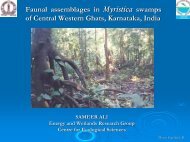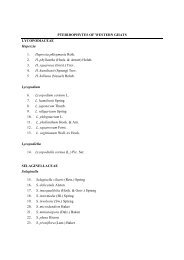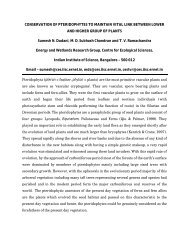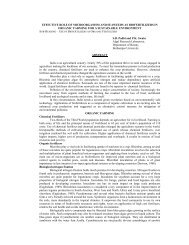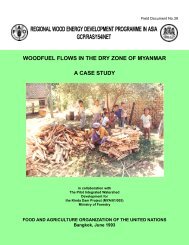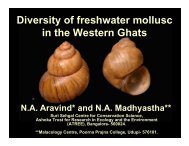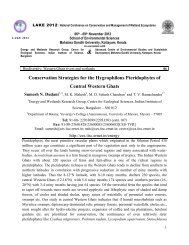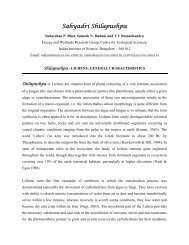Insects : As bioindicators - CES (IISc)
Insects : As bioindicators - CES (IISc)
Insects : As bioindicators - CES (IISc)
You also want an ePaper? Increase the reach of your titles
YUMPU automatically turns print PDFs into web optimized ePapers that Google loves.
<strong>Insects</strong> : <strong>As</strong> <strong>bioindicators</strong><br />
Supriya Guruprasad<br />
EWRG, <strong>CES</strong><br />
<strong>IISc</strong><br />
supriya@ces.iisc.ernet.in
<strong>Insects</strong> are the most species-rich form of<br />
animal life on Earth due to their ability to<br />
adapt<br />
Morphologically and<br />
Behaviorally to specific environments<br />
It is estimated that there are 1.5 million to<br />
30 million around the world.
Kingdom : ANIMAL<br />
Phylum: ARTHROPODA<br />
Class: INSECTA<br />
Generally sub divided into 29 orders
ORDER COMMON NAME<br />
1. Thysanura Bristletails<br />
2. Diplura Two-pronged Bristletails<br />
3. Protura -<br />
4. Collembola Springtails<br />
5. Ephemeroptera Mayflies<br />
6. Odonata Dragonflies<br />
7. Plecoptera Stoneflies<br />
8. Grylloblattodea -<br />
9. Orthoptera Crickets, Grasshoppers and Locusts<br />
10. Phasmida Stick and Leaf <strong>Insects</strong><br />
11. Dermaptera Earwigs<br />
12. Embioptera Web-spinners<br />
13. Dictyoptera Cockroaches and Mantids<br />
14. Isoptera Termites<br />
15. Zoraptera -
ORDER COMMON NAME<br />
16. Psocoptera Psocids or Booklice<br />
17. Mallophaga Biting Lice<br />
18. Siphunculata (= Anoplura) Sucking Lice<br />
19. Hemiptera True Bugs<br />
20. Thysanoptera Thrips<br />
21. Neuroptera Alder Flies, Snake Flies and Lacewings<br />
22. Coleoptera Beetles<br />
23. Strepsiptera Stylopids<br />
24. Mecoptera Scorpion Flies<br />
25. Siphonaptera Fleas<br />
26. Diptera True Flies<br />
27. Lepidoptera Butterflies and Moths<br />
28. Trichoptera Caddis Flies<br />
29. Hymenoptera Bees, Wasps and Ants
Three major body<br />
regions:<br />
• Six legs<br />
• Six legs<br />
• One pair of Antennae<br />
• Usually two pairs of<br />
wings
“Since water pollution is essentially a<br />
biological problem, making<br />
chemical measurements will be<br />
like taking snapshots of the<br />
ecosystem, whereas biological<br />
measurements will be like taking a<br />
videotape”
(1) common, diverse and abundant groups<br />
(2) ubiquitous incidence favors comparative studies<br />
(3) life cycles in wetlands<br />
(4) taxonomy is well studied<br />
(5) stationary nature help to determine the result of<br />
pollution<br />
(6) react with a range of sensitivities to numerous kinds<br />
of stressors<br />
(7) crucially important for the overall functioning of<br />
wetland ecosystems<br />
(8) routine monitoring can be relatively inexpensive
Change in pH level<br />
Change in Dissolved oxygen level<br />
in lakes<br />
Phosphates and nitrates content
Burrowers:<br />
• Broadened fore legs<br />
• Shovel-like head processes<br />
Floaters:<br />
• Buoyancy organs<br />
• Swallow air bubbles<br />
Swimmers:<br />
• Often green if cling onto vegetation<br />
Sprawlers:<br />
• Camouflage using sediments in setae
Methodology and<br />
Preservation<br />
(P.J. Gullan and P.S. Cranston, The <strong>Insects</strong>: An Outline Outline of<br />
Entomology, © 2005, Blackwell Publishing Ltd)
Identification of the segregated sample<br />
under a stereo-zoom microscope.<br />
Carrying out the required statistical<br />
analysis as per your objective.
Malathahalli lake<br />
A case study: Bangalore<br />
lake
Physico – chemical parameters<br />
Malathahalli<br />
pH 9.98<br />
DO(mg/l) 9.04<br />
Nitrates(mg/l) 0.07<br />
Phosphates(mg/l) 0.08
Order Abundance<br />
Hemiptera 1 289<br />
Hemiptera 2 1<br />
Hemiptera 3 1<br />
Diptera 1<br />
Hemiptera 4 4<br />
Odonata 1 12<br />
Odonata 2 1<br />
Hemiptera 5 1<br />
Odonata 3 2<br />
Coleoptera 6
Conclusion<br />
Dominant insect order - Hemiptera<br />
Tolerate wide ranges of pH and DO. Life<br />
doesn’t depend entirely on water<br />
quality. Some remain under water.
Thank you<br />
supriya@ces.iisc.ernet.in



